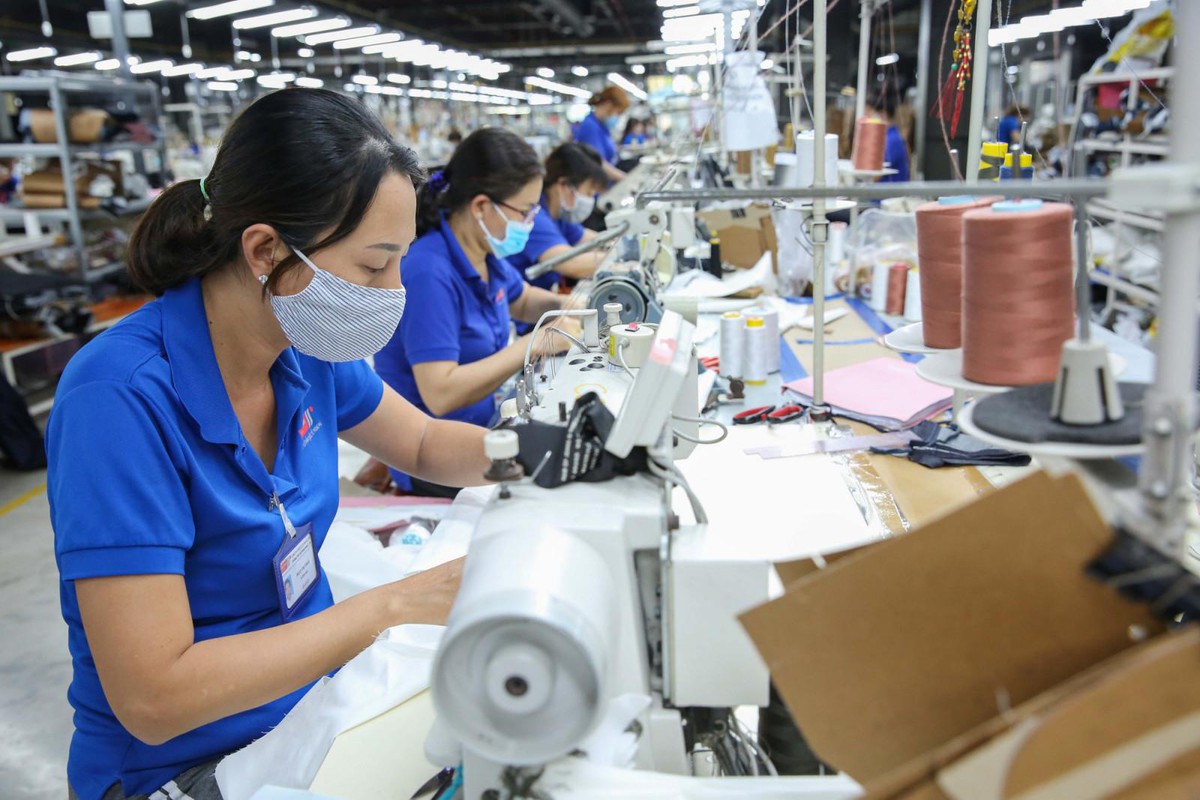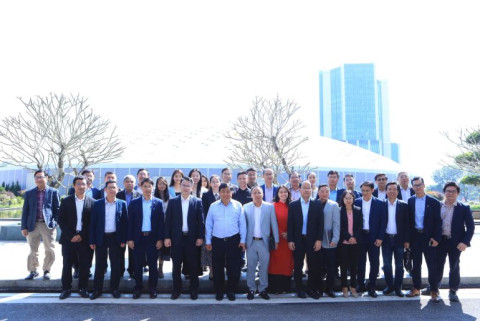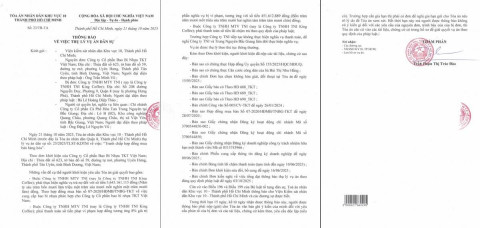Textile and Garment Businesses Face Challenges in 2024
- 216
- Business
- 15:43 15/01/2024
DNHN - Despite some positive signs in key export markets such as the US and Europe, the textile and garment industry is expected to face difficulties in 2024 due to low prices, geopolitical risks, and persistent inflation.
The current challenges in the textile and garment industry are a continuation of those faced in 2023, a year marked by difficult export market conditions. Businesses have been under pressure and faced significant challenges due to the global economic downturn, the lingering effects of the COVID-19 pandemic, and high inventory levels resulting from weakened demand, leading to job cuts and reduced working hours.

According to KinhteSaigon Online, at the 2023 Vietnam Textile and Apparel Association (VITAS) year-end conference, Mr Truong Van Cam, Vice Chairman and General Secretary of VITAS set a target of increasing the industry’s total export turnover in 2024 to $44 billion, representing a 9.2% increase compared to 2023 and nearly equivalent to the industry’s highest export turnover achieved in 2022 ($44.4 billion).
Mr. Cam stated that the economic situation in Vietnam’s major textile and garment import markets, such as the US and the EU, is showing signs of recovery, which increases the likelihood of improved demand for textile and garment products compared to last year. Additionally, the lending interest rate in Vietnam has decreased significantly, reducing the burden of interest expenses on businesses.
“The government’s current policies to support businesses may be extended in 2024. In particular, the approved Strategy for the Development of Vietnam’s Textile, Garment, and Footwear Industry to 2030, with a Vision to 2035, will be a significant advantage,” Mr. Cam acknowledged.
Meanwhile, Mr. Vu Duc Giang, Chairman of VITAS, believes that the domestic textile and garment industry is generally continuing its recovery trend. The decline in export value narrowed in the second half of 2023, and the market is expected to “warm up” in 2024.
The domestic textile and garment industry also has advantages over competing countries. These include 16 Free Trade Agreements (FTA) that are currently in effect and 3 other FTAs that are in the negotiation process and will soon come into force.
“Based on an analysis and forecast of the domestic and international situation, VITAS has set a target for the industry to achieve an export turnover of $44 billion in 2024,” Mr Giang expressed his expectations.
However, analysts and businesses believe that achieving this export turnover target will not be without its challenges. The global economy remains volatile and highly uncertain. Export orders are expected to continue to decline, with a trend towards smaller quantities, faster delivery times, supply chain risks, and high input costs.
Additionally, the risk of debt repayment, interest rate risk, exchange rate depreciation, the rapid trend towards digital transformation, and circular business models are issues that the textile and garment industry will face in the coming period.
It is noteworthy that the textile and garment industry also faces a series of challenges from “technical barriers” imposed by importing countries and fashion brands. These include the application of the EPR (Extended Producer Responsibility) and CBAM (Carbon Border Adjustment Mechanism) mechanisms, as well as the “sustainable fashion” strategy replacing “fast fashion,” the EU’s OECD supply chain due diligence directive, and Germany’s supply chain due diligence law.
The Chairman of VITAS also noted that in 2024, textile and garment businesses will face challenges as more and more major textile and garment import markets introduce new mandatory regulations. Notably, these regulations relate to the assessment of human rights and environmental impacts in the supply chain, eco-design requirements, recycled products, and the treatment of textile waste.
Given the fundamental characteristics of the market in the coming period, experts recommend that businesses develop response strategies and maintain flexibility in production and operations. This includes closely monitoring the market and partners to make forecasts and develop plans for production and maintaining business operations. With the anticipated ongoing market volatility, factories need to be flexible in switching product lines based on their ability to secure orders.
T.H
Related news
- Connecting Leaders, Shaping the Future: Strategic Leadership Planning Meeting – CorporateConnections Hanoi A
- Sunlight - Unilever Vietnam Recognized for Outstanding Contributions to the National Initiative Supporting Women Entrepreneurs
- Deputy Prime Minister Nguyễn Chí Dũng: “The country’s major challenges weigh heavily on my mind — and we must resolve them together.
- Unitsky String Technologies signs cooperation agreements with three Vietnamese partners, opening a new direction for smart mobility and sustainable development
- When artists do business – livelihood is no poetry!
- Before the D‑day to abolish flat‑rate tax: Fear of technology and costs leave small traders struggling to adapt
- Vietnamese enterprises at a crossroads: the impact of a potential US–China deal
- "Digital technicians" must not be forgotten if Vietnam aims to meet its strategic goals
- HDBank: Impressive profit growth, leading in profitability and advancing international integration
- TNI King Coffee sued for over VND 5 Billion in unpaid debts
- VINASME and Jeonnam Technopark Sign MOU on technology cooperation, human resource training, and trade promotion
- Vietnamese entrepreneurs strengthen ASEAN connectivity in the digital iIntegration era
- Prime Minister: Vietnam aims to become a regional logistics hub
- Vietnam upgraded to Secondary Emerging Market by FTSE Russell
- Hanoi’s economy grows 7.92% in first nine months of 2025, FDI surges nearly threefold
- Vietnam’s strong gdp growth fails to ease labor market distress
- US tariffs on Brazil propel Vietnam’s pangasius into global spotlight
- VietLeap AI Accelerator launches: A strategic springboard for Vietnam’s AI startups
- CICON expands strategic alliances: A new step forward in Vietnam–Korea business connectivity
- What must Vietnamese enterprises do to maintain their position in the global supply chain?
Đọc thêm Business
Connecting Leaders, Shaping the Future: Strategic Leadership Planning Meeting – CorporateConnections Hanoi A
"Your network is your most powerful flowing asset. It generates value, multiplies opportunities, and accelerates your influence across borders."
Innovative ESG enterprise: Trạm Xe Việt startup proposes solutions to build a green mobility ecosystem
As Vietnam commits to achieving Net Zero by 2050 and tightens emissions standards, the transportation sector faces unprecedented pressure to transform.
Deputy Prime Minister Nguyễn Chí Dũng: “The country’s major challenges weigh heavily on my mind — and we must resolve them together.
On the morning of November 26, 2025, Deputy Prime Minister Nguyễn Chí Dũng chaired a high-level working session at the National Innovation Center (NIC) in Hòa Lạc.
Unitsky String Technologies signs cooperation agreements with three Vietnamese partners, opening a new direction for smart mobility and sustainable development
The signing ceremony took place in Minsk, Belarus, on November 28, 2025.
Before the D‑day to abolish flat‑rate tax: Fear of technology and costs leave small traders struggling to adapt
From 1 January 2026 the flat‑rate tax regime will be abolished. Small business households will be required to declare tax based on actual revenue. MISA supports the transition with technology to help micro‑merchants adapt smoothly and transparently.
Vietnamese enterprises at a crossroads: the impact of a potential US–China deal
As the world closely monitors every shift in US-China relations, emerging signals of a strategic agreement between the two global powers are raising hopes for global economic stability.
HDBank: Impressive profit growth, leading in profitability and advancing international integration
Ho Chi Minh City Development Joint Stock Commercial Bank (HDBank, stock code HDB) announced its consolidated profit before tax for the first 9 months of 2025 reached VND 14,803 billion, marking a 17% increase year-on-year (YoY).
TNI King Coffee sued for over VND 5 Billion in unpaid debts
On October 21, 2025, the People’s Court of District 10 in Ho Chi Minh City officially accepted a civil lawsuit concerning a commercial contract dispute between TKT Vietnam Plastic Packaging Joint Stock Company and TNI King Coffee Co., Ltd.
VINASME and Jeonnam Technopark Sign MOU on technology cooperation, human resource training, and trade promotion
On October 15, 2025, in Hanoi, VINASME and Jeonnam Technopark (Korea) signed an MOU to promote trade, advance technology transfer, and develop human resources between enterprises of both nations.
Vietnamese entrepreneurs strengthen ASEAN connectivity in the digital iIntegration era
On the occasion of Vietnam Entrepreneurs’ Day (October 13), an international event themed “Integration – Innovation – Sustainable Development” was solemnly held in Ho Chi Minh City.











